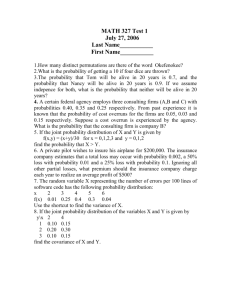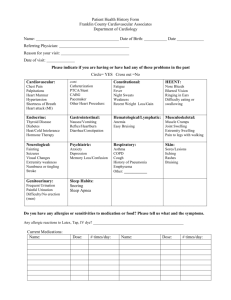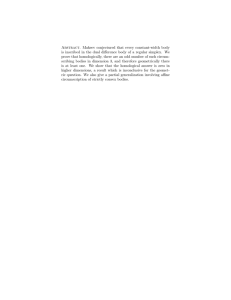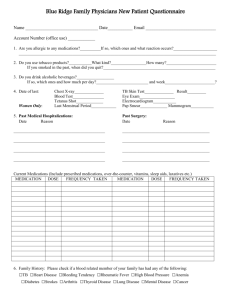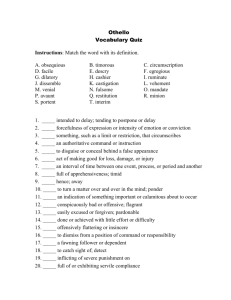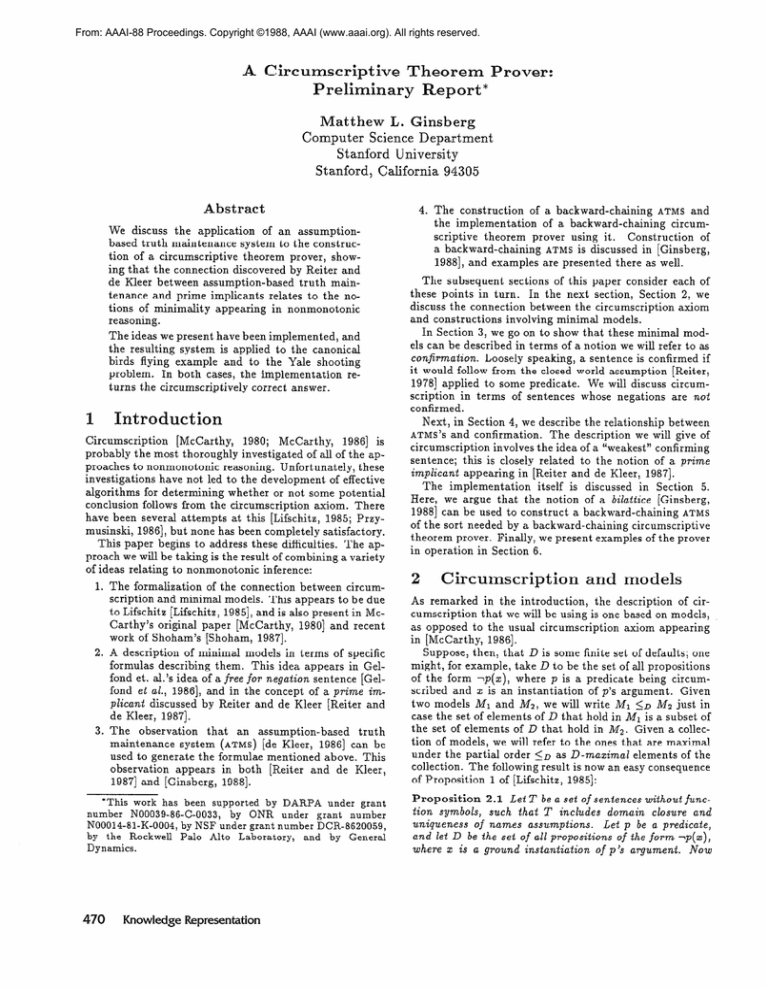
From: AAAI-88 Proceedings. Copyright ©1988, AAAI (www.aaai.org). All rights reserved.
A Circumscriptive
Theorem
Prover:
Preliminary
Report*
Matthew
L. Ginsberg
Computer Science Department
Stanford University
Stanford, California 94305
Abstract
We discuss
the application
of an assumptionbased truth maintenance
system to the construction of a circumscriptive
theorem
prover, showing that the connection
discovered by Reiter and
de Kleer between assumption-based
truth maintenance and prime implicants
relates to the notions of minimality
appearing
in nonmonotonic
reasoning.
The ideas we present have been implemented,
and
the resulting
system is applied to the canonical
birds flying example
and to the Yale shooting
problem.
In both cases, the implementation
returns the circumscriptively
correct answer.
1
Introduction
Circumscription
[McCarthy,
1980;
McCarthy,
19861 is
probably the most thoroughly
investigated
of all of the approaches to nonmonotonic
reasoning.
Unfortunately,
these
investigations
have not led to the development
of effective
algorithms
for determining
whether or not some potential
conclusion
follows from the circumscription
axiom. There
have been several attempts
at this [Lifschitz,
1985; Preymusinski,
19861, but none has been completely
satisfactory.
This paper begins to address these difficulties.
The approach we will be taking is the result of combining
a variety
of ideas relating to nonmonotonic
inference:
1. The formalization
of the connection
between circumscription and minimal models. This appears to be due
to Lifschitz [Lifschitz,
19851, and is also present in McCarthy’s
original paper [McCarthy,
19801 and recent
work of Shoham’s
[Shoham,
19871.
4. The construction
of a backward-chaining
ATMS and
the implementation
of a backward-chaining
circumscriptive
theorem
prover using it.
Construction
of
a backward-chaining
ATMS is discussed
in [Ginsberg,
19881, and examples
are presented
there as-well.
The subsequent
sections
of this paper consider each of
these points in turn.
In the next section,
Section 2, we
discuss the connection
between the circumscription
axiom
and constructions
involving minimal models.
In Section 3, we go on toshow
that these minimal models can be described in terms of a notion we will refer to as
confirmation.
Loosely speaking,
a sentence is confirmed if
it would follow from the closed world assumption
[Reiter,
19781 applied to some predicate.
We will discuss circumscription
in terms of sentences
whose negations
are not
confirmed.
Next, in Section 4, we describe the relationship
between
ATMS'S and confirmation.
The description
we will give of
circumscription
involves the idea of a “weakest” confirming
sentence;
this is closely related to the notion of a prime
implicant appearing
in [Reiter and de Kleer, 19871.
The implementation
itself
is discussed
in Section
5.
Here, we argue that the notion of a bilattice [Ginsberg,
19881 can be used to construct
a backward-chaining
ATMS
of the sort needed by a backward-chaining
circumscriptive
theorem prover. Finally, we present examples of the prover
in operation
in Section 6.
2
Circumscription
and models
3. The
observation
that
an assumption-based
truth
maintenance
system (ATMS) [de Kleer,
19861 can be
used to generate the formulae mentioned
above. This
observation
appears
in both
[Reiter
and de Kleer,
19871 and [Ginsberg,
19881.
As remarked
in the introduction,
the description
of circumscription
that we will be using is one based on models,
as opposed to the usual circumscription
axiom appearing
in [McCarthy,
19861.
Suppose,
then, that D is some finite set of defaults; one
might, for example,
take D to be the set of all propositions
of the form lp(z),
where p is a predicate
being circumscribed and x is an instantiation
of p’s argument.
Given
two models Ml and Mz, we will write Mi <D Mz just in
case the set of elements of D that hold in Mr is a subset of
the set of elements
of D that hold in Ms. Given a collection of models, we will refer to the ones that are maximal
under the partial order <D as D-maxima2 elements of the
collection.
The following result is now an easy consequence
of Proposition
1 of [Lifschitz,
19851:
*This work has been supported by DARPA under grant
number N00039-86-C-0033,
by ONR under grant number
N00014-81-K-0004, byNSF undergrantnumber
DCR-8620059,
by the Rockwell
Palo Alto Laboratory,
and by General
Dynamics.
Proposition
2.1 Let T be a set of sentences without function symbols,
such that T incbudes domain closure and
uniqueness
of names assumptions.
Let p be a predicate,
and let D be the set of all propositions
of the form -p(x),
where x is a ground instantiation
of p’s argument.
Now
2. A description
of minimal models in terms of specific
formulas describing
them. This idea appears in Gelfond et. al’s idea of a free for negation sentence
[Gelfond et al., 19861, and in the concept of a prime imp&ant
discussed
by Reiter and de Kleer [Reiter and
de Kleer, 19871.
470
Knowledge Representation
for any sentence q, q is a consequence
of circumscribing
p
in T while abbowing all other predicates to vary if and only
if q holds in all D-maximab models of T.
The approach
we will take will be to work directly from
the sets T and D, as opposed to working from the circumscription
axiom itself.
Before proceeding,
however, we should spend some time
discussing
Proposition
2.1. The assumptions
made regarding T are essentially
those needed to ensure both that we
can enumerate
all possible
instantiations
of p using constant symbols
appearing
in the original
theory, and that
these instantiations
will be nonequivalent;
these are quite
strong assumptions.’
It appears that both Proposition
2.1
and our implementation
based on it will be valid in somewhat wider circumstances;
this issue is currently
under
investigation
by Gelfond and Lifschitz
[Gelfond and Lifschitz].
Even in the general case where the proposition
may fail,
however, the argument
can be made that an algorithm
to
q holds in all Ddetermine
whether or not some sentence
maximal models of T is of comparable
interest
to one that
p in
determines
whether or not q holds after circumscribing
T: Recall that the original motivation
for the circumscription axiom was to help characterize
precisely
the notion of
predicate
minimization
appearing
in the proposition.
Confirmation
Technically,
the reason we will work with Proposition
2.1
instead of the circumscription
axiom itself is that it is possible to recast the proposition
in a somewhat
more useful
form. We need the following definition:
Definition
3.1 Let D be a set of sentences.
We will say
that a sentence
p is dnf with respect
to D if p is of the
form
j
for some collection
of dij E D. In other
disjunction
of conjunctions
of elements
of
Now also fix a set T. Then we will say
tence q is confirmed
by p for D and T
conditions
hold:
1. T U (p)
words, p is the
D.
that some senif the following
is satisfiable,
2. Tub)
l=qr and
3. p is dnf with respect
4
to D.
If no ambiguity is possible,
we wibl simply say that q is
confirmed
by p. If there is no p that confirms q, we will
say that q is unconfirmed.
If p confirms 74, we will say
that p disconfirms
q.
Confirmation
maintenance
and truth
In order to use Proposition
3.2 effectively,
we need
way to determine
the various sentences
that confirm
some
some
query 4.
Suppose
we consider the collection
of all sentences
that
confirm q. Now it is fairly clear that the disjunction
of all
of these sentences
also confirms q, and that the negation of
this disjunction
will be unconfirmed
if and only if q satisfies
the conditions
of Proposition
3.2. Thus we can determine
whether
or not q holds in all D-maximal
models of T by
considering
only the weakest of the sentences
that confirm
it.
This problem
has in fact already been addressed
in the
AI literature.
In [Reiter and de Kleer, 19871, Reiter
and
de Kleer show that assumption-based
truth maintenance
systems (ATMS'S) perform just this sort of calculation;
sim19881.
ilar remarks can be found in [Ginsberg,
Essentially,
an ATMS takes a proposition
such as q and
determines
the ‘environment’
in which q holds. One possible representation
for this environment
is as a list of contexts, where each context is described
by a list of assumptions that must hold in it. If we take the elements
of D
as our possible
assumptions,
we see that the ATMS environments
correspond
to our dnf formulae.
Since the ATMS
is looking for a minimally
specific environment
in which q
holds, we can think of it as looking for a weakest sentence
p that confirms q. Similarly,
the ATMS label assigned to lp
will tell us whether or not lp is unconfirmed.
5
VAOb
i
It is clear from this result and Proposition
2.1 that, given
information
about confirmation,
we can determine whether
or not some query q follows from a given circumscription.
mpllementation
There are some subtleties
involved in actually
implementing these ideas. Firstly, a (presumably
backward-chaining)
circumscriptive
theorem
prover will rely on a backwardchaining
ATMS;
de Kleer’s
published
work [de Kleer,
19861 is based on forward-chaining
methods.
In addition,
de Kleer’s work only describes
an ATMS for propositional
calculus;
a circumscriptive
theorem
prover will need to
work with a fully first-order
version.
We now turn to the
problem of constructing
an ATMS with these properties.
5.1
Backward
chaining
Proposition
3.2 Let T and D be sets of sentences,
and
q a sentence.
Then q holds in all D-maximal
models of T
if and only if there is some p that confirms q such that up
is unconfirmed.
Construction
of a backward
chaining
ATMS is discussed
19881. 3 The essential
idea is to construct
in [Ginsberg,
a bilattice
that corresponds
to deKleer’s
construction,
and
to then use the general-purpose
algorithms
described
in
[Ginsberg,
19881 to produce a backward
chainer that uses
this bilattice.
A description
of the ATMS bilattice
can also be found
in [Ginsberg,
19881. This bilattice
is constructed
using the
fact that the environments
described in the last section can
be partially
ordered by generality.
‘1 am indebted to Vladimir Lifschitz to providing me with
a sharp formulation of them (personal communication).
2Proofs can be found in the full paper.
3Reiter and de Kleer describe this as the “interpreted
approach” to truth maintenance
in [Reiter and de Kleer, 19871.
No algorithm is presented, however.
The reason the above
the following result:2
definitions
are useful
is because
of
Ginsberg 47 1
It is clear that the contexts
themselves,
viewed simply
as subsets
of the set, of all possible
assumptions,
can be
partially
ordered by set inclusion.
Thus if c = cl A . . . A c,
and d = dl A . . . A d, are two contexts,
we can take c 2 d
to mean that the set of ci’s contains
the set of d3’s as a
subset.
In other words, c < d if the context c is bess general
than the context d.
Using this partial order, we can construct
a partial order
on the environments
themselves,
saying that one environment el is less general than another e2 if every context in
el is less general than same context in e2. If every context
in el contains
some context
in e2 as a subset,
then the
environment
el is less general than the environment,
e2.
The points in bilattices
corresponding
to ATMS’S consist
of pairs of environments
(el, e2). If a sentence p has truth
value (el, e2), this means that el is the most general environment in which p is known to hold, and e2 is the most
general environment
in which up is known to hold.
5.2
First-order
ATMS’s
Next, we discuss the construction
of a first-order
ATMS,
as opposed to a propositional
one. In general, we need to
consider the possibility
that. the sentences
appearing
in the
various ATMS contexts
be quantified
in some way.
We will assume that this quantification
can be handled
implicitly,
as in PROLOG [Clocksin and Mellish,
19811. Existential
quantification
will be handled via Skolemization,
and universal
quantification
will be handled by assuming
that any free variables
appearing
in the database
are universally quantified.4
We will now construct
contexts
in a fashion quite similar to that of the last section;
from these contexts,
we
construct
environments
exactly
as before.
It follows that
in order to extend our propositional
ATMS to a first-order
one, we need to extend the partial order we previously
defined for contexts.
Recall that this partial order defined a
conjunctive
context
c to be less general than a context
d
just in case every sentence in c was also in d.
In the first-order
case, we need to modify the definition
only slightly,
saying that a context
c is less general than
another context
d if and only if, for each sentence
c; appearing in c, there is some sentence dj appearing
in d such
of c;.
that dj is an instantiation
Thus, for example,
the context. consisting
of the single
sentence p(z) is less general than the context
consisting
of
the sentence p(a), where z is a variable and a is a constant.
This is as it should be, since p(a) surely holds if Vz.p(z)
does.
In what follows, we will represent
contexts
using propositions and binding lists, so that the context
consisting
of
the sentence p(a) might well be represented
as
The reason
we do this is that we will frequently
have
assigned designators
to the universally
quantified
propositions,
and this representation
is slightly
more compact
4Ray Reiter has pointed out to me that not all first-order
theories can be written in this fashion.
It is not clear how
difficult it will be to generalize the following construction
to
handle these situations.
472
KnowledgeRepresentation
than restating
the proposition
involved.
Thus an element
of any particular
context, will generally
have the form
(P - A>
where p is an assumption
(i.e., an element of 0) and CTis
a binding list indicating
which variables
in p are bound in
the context.
If D consists
of the single sentence
schema
lab(z),
a context depending
on lab(a)
and lab(b)
would
be written as:
{(lab(z)
In the LISP-like
would write:
((lab(z)
. {z = a)),
notation
(lab(z)
. (z = b})).
to be used in the next
. (z = a))(lab(z)
section,
we
. {a: = b})).
Environments
will be written as lists of contexts.
Using this notation,
we see that if the value assigned
to Q after computing
the bilattice
closure is (e, f), where
e = {cl,...,%}
and
Ci= ((dij - aij)}l
then
the weakest
sentence
i
6
confirming
4 is
j
Examples
In this section,
we present
three examples
of the implemented system at work: the usual birds flying example,
a
simple example involving disjunction,
and the Yale shooting problem.
All of the ‘output’ shown is as actually
produced by the program,
except for trivial textual
modifications. (For example, the database is maintained
in disjunctive normal form, but is displayed below using a PROLOGlike representation.)
6.1
Birds
flying
Here is the database
for the usual
Bird(Tweety).
Ostrich(Fred).
Flies(x)
:- Bird(x),Not(Ab(x)).
Bird(x)
:- Ostrich(x).
Not(Flies(x))
:- Ostrich(x).
Not(Ab(x)).
birds
flying
example:
P4
Tweety is a bird, and Fred is an ostrich.
Birds fly unless
they are abnormal;
ostriches
are birds that don’t fly. By
default,
nothing is abnormal.
The ~4 labelling
the statement that nothing is abnormal
serves both to indicate that
this is a default rule, and to give the ATMS a label for this
rule.
We now ask the inference engine to find something
that
flies by giving it the query Flies(x).
Here is the result:
Flies(x)?
Invoking
multivalued
prover
on Flies(x).
Value returned
is:
binding
list:
(x = Tweety)
truth
value:
(((P4
. <x = Tweety))))
Checking
circumscriptive
context
for
truth
value
(((P4
. (x = Tweety)))).
Checking
confirmation
for
Not(Ab(Tweety)).
Negation
is unconfirmed.
x = Tweety.
Success!
The prover begins by invoking a multivalued
prover on
the query Flies(x)
[Ginsberg,
19881.
The multivalued
prover succeeds, since it. can find a proof of Flies(x)
for x
bound to Tweety.
The truth value returned
contains justification
information.
In this case, the proof that Tweety
can fly used the proposition
~4 with x bound to Tweety.
This
means
that
Flies(Tweety)
is confirmed
by
Not(Ab(Tweety)),
so the prover next checks to see if it
can find some confirmation
for the negation
of this statement,. Since Not (Not (Ab(Tweety)
> > is unconfirmed,
the
prover succeeds,
returning
the answer z = Tweety.
Alternatively,
we can look for something
that doesn’t fly:
The negation of p is block(u)
Ablock(
and this appears
to itself be confirmed
by ~15 applied
to both of a and b
(since applying
PlS to a allows us to conclude that b is a
block, and similarly for applying it to b). Thus the negation
of p is apparently
confirmed by:
lblock(a)
A lblock(b).
This sentence
is inconsistent,
with our theory,
however,
since we are assuming that either a or b is a block. Thus up
is in fact unconfirmed,
and the prover returns with success.
6.3
The Yale
shooting
Not(Flies(x))?
Invoking
multivalued
prover
on Not(Flies(x)).
Value returned
is:
binding
list:
(x = Fred)
truth
value :
TRUE
Checking
circumscriptive
context
for
truth
value
TRUE.
Negation
is unconfirmed.
Success
!
x = Fred.
Finally, we discuss the well known Yale shooting
from [Hanks and McDermott,
19871:
The prover is able to show that Fred cannot fly without
using any assumptions
at all (recall that only the default
rule about abnormality
is a possible assumption;
the other
database
facts are accepted
unconditionally).
Since TRUE
cannot be disconfirmed,
the prover informs
us that Fred
cannot fly.
The example involves a gun and an intended victim (generally named Fred). If the gun is loaded in a state s, then
Fred will not be alive in the state resulting from firing the
gun. The second axiom is a frame axiom, telling us that.
a proposition
p will hold after performing
an action a in a
state s if p held before performing
the action,
unless the
triple (a, p, s) is abnormal.
The gun is loaded and Fred is
alive in the initial state so. Finally, actions are (by default)
not abnormal.
The question is this: If we wait and then fire the gun,
do we kill Fred? Surprisingly,
the answer is no, since there
are two different ways in which we might apply the default
rules. In the first (the intended one), waiting has no effect,
and the action of firing the gun is abnormal
in the state
Do(wait ,sO) because Fred becomes not alive. The second
possibility
is one in which the waiting action is abnormal
and the gun becomes mysteriously
unloaded.
If we ask the circumscriptive
theorem
prover whether
Fred is alive after we wait and fire the gun, here is the
result:
A disjunctive
6.2
example
We next turn to an example
Block(a)
Not (Block
--
from
[McCarthy,
19801:
Not(B1 .ock(b)
ix)).
Pi5
We are told that either a is a block or b is, and circumscribe the predicate
block.
The result of the circumscription should be that either a is the only block, or b is. It
follows from this that
l[block(a)
should
be circumscriptively
A block(b)]
valid:
Not(And(Block(a),Block(b)))?
Invoking
multivalued
prover
on
Not(And(Block(a),Block(b))).
Value returned
is:
binding
list:
0
truth
value :
(((Pl5
. <x = a))>
((Pl5
. Cx = b>)))
Checking
circumscriptive
context
for
truth
value
((PI5
. <x = b>))).
(((P15
. cx = a)>>
Checking
confirmation
for
Or(Not (Block(a)
> ,Not (Block(b)
>> .
Negation
is unconfirmed.
Success
!
This example is slightly more difficult than the preceding
one. The multivalued
prover manages
to prove the query
by using either ~15 with x bound to a, or with x bound to
b. Thus the query is confirmed
by:
p 5 lblock(a)
V Tblock(b).
Not(Holds(alive,Do(shoot,s)))
Holds(loaded,s).
Holds(p,Do(a,s))
:Holds(p,s;,
Not(Ab(a,p,s)).
Holds (loaded,sO)
.
Holds(alive,sO).
Not(Ab(a,p,s)).
example
:-
P23
Holds(alive,Do(shoot,Do(wait,sO)))?
Invoking
multivalued
prover
on
Holds(alive,Do(shoot,Do(wait,sO))).
Value returned
is:
binding
list:
0
truth
value:
(((P23
. (a = wait,
p = alive,
s = SO>)
(P23 . (a = shoot,
p = alive,
S = Do(wait,sO)))>>
Checking
circumscriptive
context
for
truth
value
(((P23
. (a = wait,
p = alive,
s = SO))
(P23 . <a = shoot,
p = alive,
S = Do(Wait,sO>)>)>.
Checking
confirmation
for
And(Not(Ab(wait,alive,sO)),
Not(Ab(shoot,alive,Do(wait,sO)))).
Negation
confirmed
based
on truth
value
(((P23
. (a = wait,
p = loaded,
s=sO)))).
Fails.
Ginsberg
473
The system
first notes that it can prove that Fred is
alive simply by applying
the frame axiom twice, first to
conclude that he is alive after the waiting action, and then
to conclude that he remains alive after the shooting action.
Thus his being alive is confirmed
by:
lab(aait,alive,so)
The negation
A lab(shoot,
of this sentence
alive,do(wait,so)).
is confirmed
by
lab(wait,loaded,so),
however.
If wait is not abnormal
in SO, then the gun will
be loaded after the waiting action, and Fred will necessarily
be dead after the gun is fired. Since there is no proof of
the negation
of this sentence,
the confirming
sentence for
the original query is itself disconfirmed,
and the query does
not follow from the circumscription.
Alternatively,
we can try to show that Fred is not alive
after the sequence of actions:
Not(Holds(alive,Do(shoot,Do(wait,sO))))?
Invoking
multivalued
prover
on
Not(Holds(alive,Do(shoot,Do(wait,sO)))).
Value returned
is:
binding
list:
<)
truth
value:
(((P23
. <a = wait,
p = loaded,
s = SO))))
Checking
circumscriptive
context
for truth
value
. <a = wait,
p = loaded,
s = ~03))).
(((P23
Checking
confirmation
for
Not(Ab(wait,loaded,sO)).
based
on truth
value
Negation
confirmed
(((P23
. <a = wait,
p = alive,
s = SO))
(P23 . {a = shoot,
p = alive,
s = Do(wait,sO>>>>>.
Fails.
Now a proof is found indicating
that Fred will not, be
alive after the gun is fired, provided that waiting did not
cause it to become unloaded.
The negation
of the confirming fact is ab(wait,
loaded, SO), but this follows from the
conjunction
lab(wait,alive,so)
A lab(shoot,alive,do(wait,so)).
Since the negation of the above
of
the confirmation
lholds(alive,do(shoot,
sentence
cannot
be proven,
do(wait,so)))
is disconfirmed,
and the prover fails.
In all of these examples,
the prover returns
the correct
circumscriptive
answer.
In addition,
the computational
procedure
used is reasonably
efficient.
The Yale shooting
problem,
for example,
is solved in approximately
one sec3600.
ond on a Symbolics
Acknowledgement
I would like to thank Johan de Kleer,
Benjamin
Grosof,
John
McCarthy,
Karen
Myers,
Ray Reiter
and David
Smith for many useful discussions
and suggestions.
I am
especially
grateful
to Vladimir
Lifschitz
for the assistance
he has given me in sharpening
the results of Section 2, and
in directing
me to Gelfond’s
paper [Gelfond et al., 19861.
474
Knowledge
Representation
References
[Clocksin and Mellish, 1981:
Programming
Hellish.
Berlin, 1981.
[de Kleer, 19861 Johan
truth
maintenance
28:127-162,
1986.
W. F. Clocksin
and C.
57 .?rolcg.
Springer-Verlag,
de Kleer.
system.
S.
An assumption-based
Artificial
Intelligence,
[Gelfond and Lifschitz]
Michael Gelfond and Vladimir Lifschitz.
Compiling
circumscriptive
theories
into logic
programs.
In preparation.
[Gelfond et al., 19861 Michael Gelfond, Halina Przymusinska, and Teodor Przymusinski.
The extended
closed
world assumption
and its relationship
to parallel
circumscription.
In Proceedings
of ACM SIGACTSIGMOD
Symposium
on Principles
of Database Systems, pages 133-139,
1986.
[Ginsberg,
19881 Matthew
L. Ginsberg.
Multivalued
logits: A uniform approach
to reasoning
in artificial
intelligence.
Computational
Intelligence,
4, 1988.
[Hanks and McDermott,
19871 Steve
Hanks
and
Drew
McDermott.
Nonmonotonic
logics and temporal
projection.
Artificial
Intelligence,
33:379-412,
1987.
[Lifschitz,
19851 Vladimir
Lifschitz.
Computing
circumof the Ninth International
scription.
In Proceedings
Joint Conference
on Artificial Intelligence,
pages 121127, 1985.
[McCarthy,
19801 John McCarthy.
Circumscription
- a
form of non-monotonic
reasoning.
Artificiab Intebiigence, 13:27-39,
1980.
[McCarthy,
19861 John McCarthy.
Applications
of circumscription
to formalizing
common sense knowledge.
Artificial Intelligence,
28:89-116,
1986.
Query[Przymusinski,
19861 Teodor
C. Przymusinski.
answering in circumscriptive
and closed-world
theories. In Proceedings
of the Fifth National Conference
on Artificial Intelligence,
pages 186-190,
1986.
[Reiter,
19781 Ray Reiter.
On closed world data bases. In
H. Gallaire
and J. Minker,
editors,
Logic and Data
Bases, pages 119-140,
Plenum,
New York, 1978.
[Reiter and de Kleer, 19871 Raymond
Reiter
and Johan
de Kleer.
Foundations
of assumption-based
truth
maintenance
systems:
Preliminary
report.
In Proceedings of the Sixth National Conference
on Artificial
Intelligence,
pages 183-188,
1987.
[Shoham,
19871 Yoav Shoham.
A semantical
approach
to
In Proceedings
of the Tenth
nonmonotonic
logics.
International
Joint Conference
on Artijkiab
Intel&
1987.
gence, pages 388-393,

